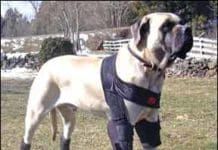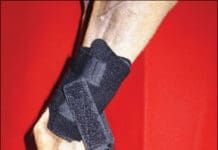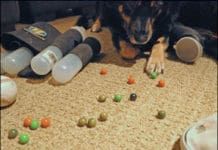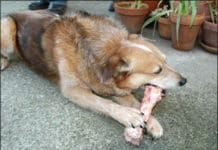Home Search
senior%20dog%20care - search results
If you're not happy with the results, please do another search
How to Set Up a Pet Trust to Ensure Your Dog is Cared For...
and build alternatives into the plan in case some aspects of your ideal scenario are not feasible for your pet's caretaker.üThe single owner of two dogs with significant behavioral issues (both exceedingly shy Shar-pei)
Orthopedic Equipment for Dogs that Increase Joint Support and Overall Mobility
In our March 2011 issue, we introduced you to a very small sampling of some of the neat “assistive equipment” options that are available to help our canine companions who have limited mobility or other physical issues. We received such a great response that we thought we’d share with you a few more finds that can help make life easier for you and your dog, particularly if he or she is aging or has orthopedic or neurologic issues. Remember: the products mentioned here are only the tip of the iceberg. There are numerous companies making innovative assistive products; what we’re hoping to do here is to get you thinking about some of the possibilities!
Orthopedic Equipment for Dogs Designed for Increased Mobility and Extra Support
Do you have a dog recovering from orthopedic or neurologic surgery, one who has mobility issues, or a senior dog who has arthritis? If so, at some point, you have probably wished you could do something anything! to help make your dog's life (and your own) a little easier. I asked two veterinarians who specialize in canine rehabilitation to share some of their top picks for canine assistive/rehabilitative equipment. Laurie McCauley, DVM, CCRT, is founder and medical director of TOPS Veterinary Rehabilitation in Grayslake, Illinois, and is considered one of the pioneers in the field of veterinary rehabilitation. Evelyn Orenbuch, DVM, CAVCA, CCRT, recently opened Georgia Veterinary Rehabilitation, Fitness and Pain Management in Marietta, Georgia, and has focused on veterinary rehab medicine since 2003.
Think Ahead When Adding Dogs to Your Family
Back in 1998, we were a happy one dog family, made complete by the light of my life dog, Axel, a grand Bouvier des Flandres. So why did I have to mention in passing to his groomer, a woman active in Bouvier rescue, that maybe we’d like to add another?
Treatment and Prevention of Kidney and Bladder Stones
Canine kidney and bladder stones may be painful and life-threatening, but an informed caregiver can help prevent them. By far the most common uroliths or stones in dogs are struvites and calcium oxalate stones. These two types represent about 80 percent of all canine uroliths. Now we address the remaining stones that can affect our best friends: urate, cystine, calcium phosphate, silica, xanthine, and mixed or compound uroliths.
Canine Health News and Current Events December 2009
My dog Ella and I spent an anxious night at the emergency clinic recently, after she found and ate paintballs while on our walk. She was off-lead at the time, so when I realized what she was doing, I had no way of knowing how many she had eaten. In fact, I did not immediately recognize the colorful, marble-sized gelatinous balls, and thought they were some kind of candy. It was only a few hours later, when she threw up bright turquoise, that I became concerned and investigated further. Paintballs ingredients can include polyethylene glycol, dipropylene glycol, glycerol, and sorbitol, all osmotic laxatives, which can lead to hypernatremia (“salt poisoning”) when ingested in sufficient quantity. These ingredients also taste sweet, which is why dogs find paintballs so attractive.
Helping Your Dog Lose Weight
When Ella, a five-year-old Norwich Terrier, first came to live with me a few months ago, she weighed a svelte 10.8 pounds. But within two months her weight had ballooned by almost a full pound, and there was no way you could call her anything but plump. How could this happen? How could I have let my new dog get fat me, the one who perpetually preaches the benefits of keeping dogs lean? And what the heck was I going to do about it? The answer is that it happened because Id never owned such a small dog before, and it turned out I was massively overfeeding her, particularly when I counted all the treats she was getting. And I would do whatever it takes to get her back to the weight she should be, and keep her there. Here is what I learned during my struggle to help Ella lose weight.
Dog Fostering Programs
he was adopted by a perfect family."
High Quality Dog Food in its Various Forms
knowledgeable owners who would recognize the signs of nutritional deficiencies
Home-Prepared Dog Food
including ground meat
One Lucky Puppy
When our grandparents (or perhaps great-grandparents) were children, it was not uncommon for people to have big families – say, eight or 10 or more kids – but to have only a few survive due to childhood diseases, a lack of modern medical care, and, sometimes, poor nutrition. This is a story of Dusty, a dog with just such a background; he is the sole survivor from a litter of 11 puppies. But despite being born in modern times, superior medical care and technology failed to save Dusty’s siblings.
Proper Use of Head Halters for Leash Training
Ten years ago, a new dog training tool hit the market. Known generically as the head halter (or head collar), it is a device similar to the halter commonly used on horses. It provides a greatly increased degree of control over the dog who is dedicated to pulling on the collar and leash, without the punishment or pain factors associated with choke chains and prong collars. The head halter has a strap that goes around the dog’s nose, and another that clasps around his neck, just behind the ears. The leash attaches to a ring below the dog’s chin. Just like with halters on horses, bulls and other large animals, it works on the principle that where the nose goes, the body must follow.










